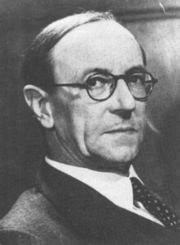
James Chadwick
James Chadwick 1891-ci il oktyabrın 20-de İngilterenin Cheshire şeherinde anadan olmuşdur. James milliyetce ingilisdir. Tehsilini Rutherford-un telebesi kimi Manchester Universitetinde aldı. 1919-cu ilde çalışmağa başladığı Cambridge Universitetinde 1935-ci ile qeder oradakı işine davam etdi. Esas elmi işleri nüve fizikasının problemleri olmuşdur.
1923-cü ilde Cavendish Laboratoriyasının Tedqiqatlar şöbesinin müdürü vezifesine keçmişdir.
1927-ci ilde ise Royal Society-nin müxbir üzvü seçildi.
1932-ci ilde neytronu keşf etdi ve 3 il sonra bu keşfine göre 1935-ci ilde Nobel mükafatı laureatı adına layiq görülmüşdür. Bundan başqa 1935-ci ilde Liverpool Universitetinin fizika kürsüsüne keçdi. İkinci Dünya Müharibesi dövründe Los Alamos-dakı atom tedqiqatlarına başçılıq etdi. 1948-ci ilde Cambridge-deki bir kollecin müdürü vezifesine keçdi. Deteryumun qamma şüaları ile parçalanmasını tedqiq ederek nüve fotoelektrik effektini tapdı.
James Chadwick 24 iyul 1974-cü ilde Cambridge-de vefat etdi.
in english
James Chadwick
Sir James Chadwick (October 20, 1891 – July 24, 1974) was an English physicist and Nobel laureate.Chadwick was born at Cheshire the 20th of October 1891. He went to Manchester High School, (England) and studied at the Universities of Manchester and Cambridge. His father was John Joseph Chadwick and his mother was Mary Anne Knowles.
In 1914 Chadwick went to work with Hans Geiger at the Technische Hochschule in Berlin (today the Technical University of Berlin). He also worked with Lord Rutherford. During the First World War Chadwick was interned in Germany as an enemy alien.
After the war Chadwick returned to Cambridge where he worked with Ernest Rutherford in investigating the emission of gamma rays from radioactive materials. They also studied the transmutation of elements by bombarding them with alpha particles, and investigated the nature of the atomic nucleus.
In 1932 Chadwick made a fundamental discovery in the domain of nuclear science: he discovered the particle in the nucleus of an atom that became known as the neutron because it has no electric charge. In contrast with the helium nuclei (alpha particles) which are positively charged, and therefore repelled by the considerable electrical forces present in the nuclei of heavy atoms, this new tool in atomic disintegration need not overcome any electric barrier and is capable of penetrating and splitting the nuclei of even the heaviest elements. In this way, Chadwick prepared the way towards the fission of uranium 235 and towards the creation of the atomic bomb. For this epochal discovery he was awarded the Hughes Medal of the Royal Society in 1932, and subsequently the Nobel Prize for Physics in 1935. Later, he found out that a German scientist had discovered the neutron at the same time. But Hans Falkenhagen (Rostock) was afraid of publishing his results. When Chadwick learned of Falkenhagen's discovery, he offered to share the Nobel Prize with him. Falkenhagen, however, modestly refused the honour.
Chadwick’s discovery made it possible to create elements heavier than uranium in the laboratory. His discovery particularly inspired Enrico Fermi, Italian physicist and Nobel laureate, to discover nuclear reactions brought by slowed neutrons, and led Lise Meitner, Austrian physicist, to the discovery of “nuclear fission”, which triggered the development of an atomic bomb..
He died in Cambridge the 24th of July 1974.

0 Comments:
Post a Comment
<< Home